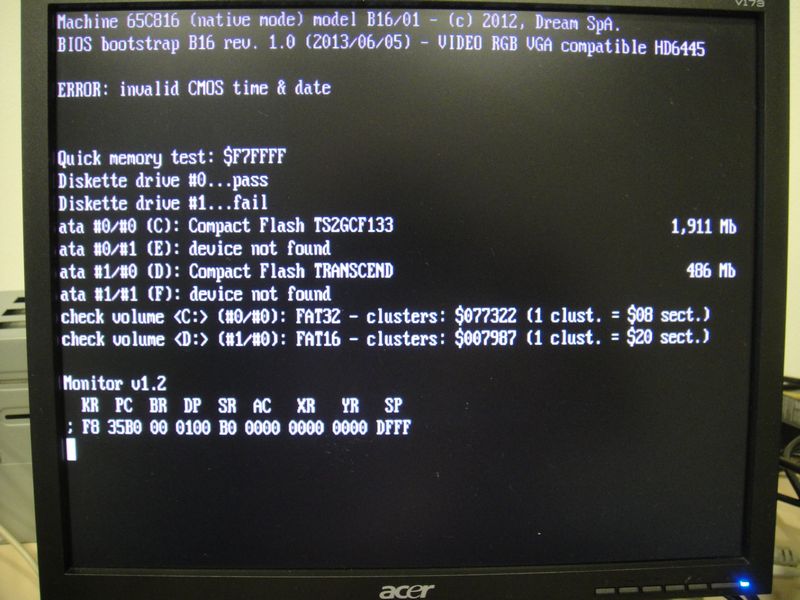The screen in the VGA monitor after boot.After the check of memory and IO subsystem, the BIOS detect ATA devices and the type of file system,
then launches the system monitor waiting command.
The screen in the VGA monitor after boot of the second computer.The character font is the standard font of PC in text mode (DOS).
| HARDWARE SUMMARY |
| CPU |
Either 65C816 or 65C02 with PHI2 selectable at 4MHz or 2MHz (by dip-swith in cpu board) |
| Standard RAM |
65C818: all linear address space filled with 16Mb |
| 65C02: 768Kb banked plus 128Kb for DMA |
| FLASH memory |
65C818: 512Kb plus optional 512Kb |
| 65C02: 256Kb banked (8 banks of 32Kb) |
| Extended RAM |
2Mb banked (256 banks) in a window of 8Kb |
| Video RAM |
64Kb with MOS8563 on-board |
| 5Kb with optional video board |
| Storage |
Two ATA port (data transfer in PIO-mode) for attach PATA hard-disk and/or Compact Flash (via adapter) |
| One FDC port (virh DMA transfer) for attach standard PC floppy (DD/HD floppy) |
| Keyboard |
Standard PC keyboard old type (DIN connector) or PS/2 (miniDIN) via adapter |
| Communication |
Two RS232 port with full handshake (baude rate selectable from 50 to 38.400 bps) |
| One RS485 port (baude rate selectable from 50 to 38.400 bps) |
| Video output |
PAL/NTSC compatible with MOS8563 on-board and SCART connector.
Video attributes: alternate font, reverse, blinking, underline, 16 foreground colors. Screen org.: 80 columns x 25 rows. Font: VGA 8x8 |
| VGA compatible with optional video board.
Video attributes: reverse, blinking, underline, 16 colors foreground/background (only 32 or 64 combination at time possible).
Screen org.: 80 columns x 25 rows. Font: VGA 8x16. |
| Expansion Bus |
Six free I/O slot eurocard standard |
| Power Supply |
PC Standard |
| |
|
| Planning for the future |
A new FDC/ATA board with full DMA (either for FDC and ATA port) |
| Board with standard printer port and floating point co-processor MC68882 |
| Audio board with SN76489 |
| Standard IEEE-488/GPIB board |
| A standard PS2 mouse controller |


